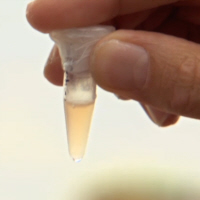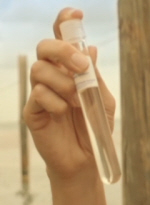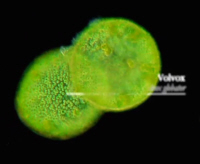Rhodopsin
Light Detection Molecule
What is Life?

Rhodopsin
Because on a molecular level, every eye in the world works in the same way. In order to form an image of the world, then obviously the first thing you
have to do is detect light, and I have a sample here of the molecules that do that, that detect light in my eye. Its actually, specifically, the molecules
that's in the black and white receptor cells in my eyes, the rods. It's called rhodopsin. And the moment I expose this to light, you will see an
immediate physical change.
There you go. Did you see that? It was very quick. It came out very pink indeed, and it immediately went yellow.
This subtle shift in colour is caused by the rhodopsin molecule changing shape as it absorbs the light. In my eyes, what happens is that the change in
structure triggers an electrical signal which ultimately goes all the way to my brain, which forms an image of the world. It is this chemical reaction
that is responsible for all vision on the planet.
Closely related molecules lie at the heart of every animal eye. And that tells us that this must be a very ancient mechanism. To find its origins, we
must find a common ancestor that links every organism that uses rhodopsin today.

Heron Eye

Algae, Volvox
We know that common ancestor must have lived before all animals' evolutionary lines diverged. But it may have lived at any time before then.
So what is that common ancestor? Well, here's where we approach the cutting edge of scientific research. The answer is that we don't know for sure,
but a clue might be found here, in these little green blobs, which are actually colonies of algae, algae called volvox.
We have very little in common with algae. We've been separated in evolutionary terms for over a billion years. But we do share one surprising
similarity. These Volvox have light-sensitive cells that control their movement. And the active ingredient of those cells is a form of rhodopsin so
similar to our own that it's thought they may share a common origin. What does that mean?
Does it mean that we share a common ancestor with the algae, and in that common ancestor, the seeds of vision can be found?
To find a source that may have passed this ability to detect light to both us and the algae, we need to go much further back down the
evolutionary tree. To organisms like cyanobacteria. They were among the first living things to evolve on the planet, and it's thought that
the original rhodopsins may have developed in these ancient photosynthetic cells.
So the origin of my ability to see may have been well over a billion years ago, in an organism as seemingly simple as a cyanobacterium.
The basic chemistry of vision may have been established for a long time, but it's a long way from that chemical reaction to a fully
functioning eye that can create an image of the world.
The eye is a tremendously complex piece of machinery, built from lots of interdependent parts, and it seems very difficult to imagine how
that could have evolved in a series of small steps, but actually, we understand that process very well indeed.



